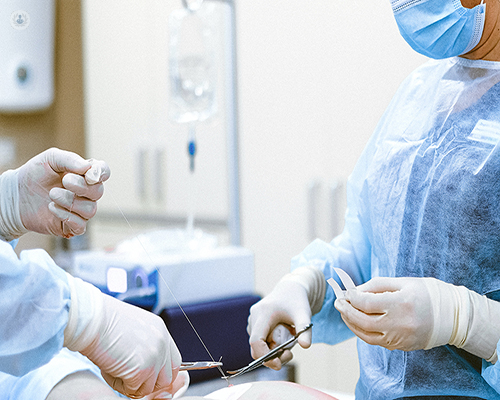Diagnosing and treating Gilmore’s Groin
Escrito por:In his last article, "Gilmore’s Groin: Not just a sportsman’s problem", revered consultant surgeon and surgical director of the Gilmore Groin and Hernia Clinic, Mr Simon Marsh, explained exactly what Gilmore's Groin is and how the founder of The Gilmore Groin and Hernia Clinic at 108 Harley Street, Jerry Gilmore diagnosed the condition when other surgeons failed to determine the cause. Gilmore’s Groin is a painful groin injury, with which many patients are falsely diagnosed if the source of their pain isn’t correctly diagnosed. In his most recent article, London-based Mr Marsh outlines clearly the symptoms of and treatment options for Gilmore’s Groin.

What are the symptoms of Gilmore’s Groin?
The symptoms of Gilmore’s Groin are very specific and they’re part of the three things a doctor does when looking for the condition. First of all, the doctor will listen to your symptoms, secondly, they will examine you and finally, they will do some investigations (in this case, some scans, MRI for example).
There is a specific set of symptoms people get before and after exercise that is typical of Gilmore’s groin. Footballers, for example, will get pain when they push off to sprint, when they change direction suddenly, or when they’re kicking longballs or dead balls. A rugby union player may experience a similar pain particularly if they are the goal kicker.
Typically, symptoms would present the next day after playing sports. Classically, the person is stiff and sore, and in some cases, they have difficulties walking for a day or two. They may experience pain if they’re getting up from a low position, like getting out of bed, or a low sports car perhaps. Pain might also occur when they cough or sneeze because the abdominal muscles stretch as a result.
Just as there's a very specific pattern of symptoms both during and after exercise, there's a very specific site of where the pain occurs. The location is very specific, over the area called the superficial inguinal ring which is just above the crease in the thigh, the lower part of the tummy.
Can Gilmore’s Groin heal itself?
Believe it or not, we try very hard not to operate on a patient who has Gilmore’s Groin. We always try and get it to settle conservatively, meaning without an operation, with a combination of physiotherapy and rehabilitation. Some of the time it settles, but it can take a while. It does depend also on what you do professionally. For example, if you’re a sportsman and your livelihood depends on you playing a sport, you’re going to want an operation sooner than an amateur or someone who just plays at the weekend and is prepared to give it more time to settle.
Additionally, it depends on what we find in the examination. If there is a widely dilated superficial inguinal ring and a lot of pain, things probably aren’t going to go away by themselves. If it is interfering with the patient’s job, their normal daily activities, or they're not able to do the things they’d like to do, then we would consider performing an operation.
How is Gilmore’s Groin treated?
If the condition does not improve by itself, then surgery may be required. To perform this surgery, it’s vital to have a thorough knowledge of the anatomy of the groin, as the late Jerry Gilmore did, when he first worked out what was going on. This means understanding where the muscles, tendons, and nerves are and how they all work together. Almost everybody accepts that the syndrome of Gilmore's Groin is a problem with the muscles and tendons of the anterior abdominal wall, the front of the tummy, so the only way to really operate is from the front. There are three layers of muscles that need to be considered and they are repaired anatomically, meaning the torn muscles will be put back to where they should be, with stitches that will all dissolve over 2-3 months.
In 2010, Jerry and I had a metaphorical “sit-down” and thought about how the operation could be improved. Since then, we also do what we call an inguinal ligament tenolysis. The inguinal ligament attaches to the pelvis; it can get very tight and cause some inflammation around the pelvis, a condition called osteitis pubis, which can be secondary to the torn groin. When we operate, we release this tendon to reduce some of the tension. We then repair all the muscles anatomically. When the stitches dissolve, normal muscles and tendons are back in the right place.
Some surgeons treat Gilmore’s Groin with a mesh but I don’t see the logic in that. If a patient has torn muscles and tendons, then the muscles and tendons should be repaired. If you put a plastic patch, a mesh, over the front of these muscles, the anterior abdominal wall will be stiffened, but the muscles and tendons won’t be repaired and they still won’t work properly. People come and see me, who say they had their sports hernia repaired with a mesh six months ago and ask me why it still hurts. The answer is because the muscles and tendons haven’t been repaired, a mesh has just been placed over them. It’s the same with the laparoscopic approach when an even bigger mesh is put inside the tummy to stiffen the abdominal wall. But, again, this doesn’t do anything for the torn muscles and tendons on the anterior abdominal wall at the front. Neither of these mesh-based approaches seems logical to me. It is the anatomical suture repair that is required to treat Gilmore’s Groin properly.
If you would like to book a consultation with the acclaimed Mr Simon Marsh, you can do so by visiting his Top Doctors profile.


